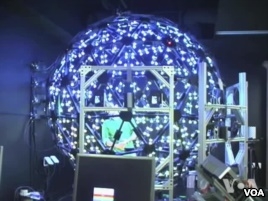From VOA Learning English, this is the Technology Report.
Movie fans know that their action hero Superman does not really fly. And, in the movie Superman Returns, another visual trick is played on viewers. The man they see flying is not real. He is what is called a virtual actor. The first step in creating this digital actor is to have a real person stand in a room called a light stage. A computer then captures the outlines and shapes of his face and records how they throw off light. Paul Debevec is with the Institute for Creative Technologies at the University of Southern California.
"We can light them with very specially computer-controlled illumination and take photos of them from seven different viewpoints with high resolution digital still cameras."
Mr. Debevec is part of a team working to create computerized images of people, objects and environments that look and act real. The light stage permits actors to be turned into digital versions of themselves much like the blue creatures in the movie Avatar. The real world could soon be using a similar technology. Computer experts at the Institute are developing a 3-D video teleconferencing system. It would send a video image of a person into a meeting room. That image would be able to work with the people in the room, who would see it in 3-D without special eyeglasses. Paul Debevec says:
"The person who is being transmitted to a remote location can actually look around at the people in the room and everybody in that room knows who they're looking at. And that's such a fundamental part of human communication."
He believes the business world will begin to use 3-D video teleconferencing in the next five years.

3D Leaps From Movies To Real World
The Institute is using its light stage and Interactive 3-D Display technology to record video testimonies of Holocaust survivors for the Shoah Foundation.
"Do you remember any songs from your youth?"
"This is a lullaby that my mother used to sing to me and I still remember it. It's in polish."
The Foundation is also at the University of Southern California. The 3-D images will be shown on special screens in classrooms or museums and will be set up to answer questions about the Holocaust from students and visitors.
"It could be about faith. It could be about love. It could be about beliefs. It could be about identity."
Kim Simon is managing director of the Shoah Foundation.
"It's also a medium with which young people today are particularly comfortable. And, the amount of information that comes through seeing a person's face and hearing their voice at the same time is multiplied."
A demonstration of an interaction between a Holocaust survivor and students may be possible in a year. In 10 years, we may be able to play 3-D video games without special glasses.
译文属可可原创,仅供学习交流使用,未经许可请勿转载













